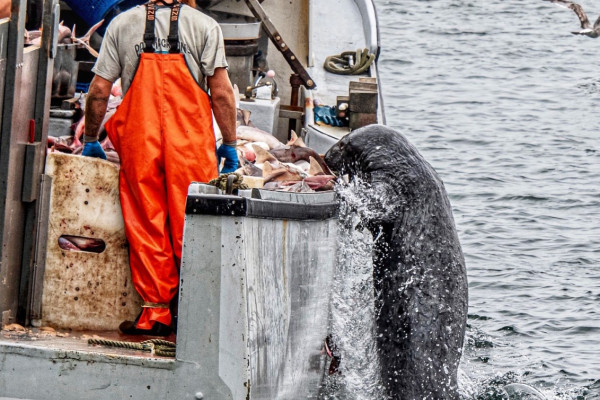
Many support further study of seals as well as cooperative research with fishermen to reduce interactions. Photo by Christine Walsh Sanders.
By Doreen Leggett
In Sweden, fishermen, regulators, and environmental organizations work with government funding dedicated to developing fishing gear that is safe for seals.
In the United States, that doesn’t happen. There is a section of the Marine Mammal Protection Act that provides fishermen with opportunity to deter seals, but to avoid penalties they are supposed to abide by a list of recommendations produced by National Marine Fisheries Service.
That list does not yet exist.
“So fishermen are in sort of a quandary,” said George Maynard, who earlier did research work at the Fishermen’s Alliance, adding that fishermen can be legally responsible if a seal is hurt.
Maynard, now at the federal Northeast Fisheries Science Center, spoke at the annual meeting of the Northwest Atlantic Seal Research Consortium (NASRC) early this summer, which is the next closest thing to the Swedish model in the region. Andrea (Dre) Bogomolni, a community scientist, saw the need to work together and co-founded what is now the consortium more than a decade ago. This meeting’s theme was the “Power of Partnerships,” held jointly with the fisheries science center on Zoom.
While still at the Fishermen’s Alliance, Maynard worked on testing an acoustic deterrent for seals. The non-profit invested close to $30,000 in equipment, staff time and permitting for a device, shipped from Scotland, that ultimately didn’t work.
Fishermen “don’t have the time, staff, or capital to make those kinds of investments,” Maynard said.
Even recently drawn up draft rules meant to help fishermen have pitfalls. Many concentrate on minimizing harm to animals, which is laudable, but there is little hard information on cost or effectiveness and at least two options – sponge grenades and pyrotechnics – aren’t legal in Massachusetts.
Maynard said the growing concern, and one of the reasons for the meeting, is the increasing number of seals hurt or killed unintentionally by commercial fishermen. While a valid concern, what is less often talked about is grey seals in the region are still increasing exponentially.
The increasing number of seals locally is also causing significant financial losses for fishermen, especially in weirs.
Entanglements destroy expensive gear, but what is more frequent is seals eating catch in the nets before the gear is hauled.
Several of those on the panel, which included Kimberly Murray from the fisheries science center and Sarah Sharp of the International Fund for Animal Welfare, supported further study of seals as well as cooperative research with fishermen to reduce interactions.
“We need more research that explores the relationship between seals and other parts of the environment,” Murray said, including economic and social research.
Murray said models exist that show the encounter risk of seals with gear.
This work helps “identify areas where you may have bycatch and work with fishermen in those areas to design better solutions,” Murray said. “The bycatch is becoming an increasing problem for both the seals and the fishermen. It is really important that we start thinking about solutions.”
Sharp agreed, saying the end game is the same for all: working to eliminate seals eating catch and becoming entangled in nets.
“We can only get there by working together,” Sharp said.
Bogomolni is working toward that with a cooperative research team led by Captain Doug Feeney of Chatham, Owen Nichols, Director of Marine Fisheries Research at the Center for Coastal Studies in Provincetown and Alex Bocconcelli, at the Woods Hole Oceanographic Institution.
They have installed cameras on gillnets to see how seals interact, to try and minimize encounters. But they need more funding to build on their success, Feeney said.
“We have already learned so much, and there is so much more to learn,” he said. “We all have the same mission, which is to find the answers.”
